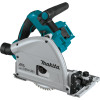Makita XPS01Z XPS01 Instruction Manual - Page 5
Short Pieces By Hand
 |
View all Makita XPS01Z manuals
Add to My Manuals
Save this manual to your list of manuals |
Page 5 highlights
7. Use extra caution when sawing into existing walls or other blind areas. The protruding blade may cut objects that can cause kickback. 8. ALWAYS hold the tool firmly with both hands. NEVER place your hand, leg or any part of your body under the tool base or behind the saw, especially when making cross-cuts. If kickback occurs, the saw could easily jump backwards over your hand, leading to serious personal injury. 2. Use extra caution when cutting damp wood, pressure treated lumber, or wood containing knots. Maintain smooth advancement of tool without decrease in blade speed to avoid overheating the blade tips and if cutting plastics, to avoid melting the plastic. 3. Do not attempt to remove cut material when blade is moving. Wait until blade stops before grasping cut material. Blades coast after turn off. 4. Avoid cutting nails. Inspect for and remove all nails from lumber before cutting. 5. Place the wider portion of the saw base on that part of the workpiece which is solidly supported, not on the section that will fall off when the cut is made. If the workpiece is short or small, clamp it down. DO NOT TRY TO HOLD SHORT PIECES BY HAND! 9. Never force the saw. Push the saw forward at a speed so that the blade cuts without slowing. Forcing the saw can cause uneven cuts, loss of accuracy, and possible kickback. Guard function 1. Check the guard for proper closing before each use. Do not operate the saw if the guard does not move freely and enclose the blade instantly. Never clamp or tie the guard so that the blade is exposed. If the saw is accidentally dropped, the guard may be bent. Check to make sure that the guard moves freely and does not touch the blade or any other part, in all angles and depths of cut. 2. Check the operation and condition of the guard return spring. If the guard and the spring are not operating properly, they must be serviced before use. The guard may operate sluggishly due to damaged parts, gummy deposits, or a build-up of debris. 3. Assure that the base plate of the saw will not shift while performing a "plunge cut". Blade shifting sideways will cause binding and likely kick back. 4. Always observe that the guard is covering the blade before placing the saw down on bench or floor. An unprotected, coasting blade will cause the saw to walk backwards, cutting whatever is in its path. Be aware of the time it takes for the blade to stop after the switch is released. Additional safety warnings 1. Intended use This tool is specially intended for performing plunge cuts. The tool is also intended for rip and cross cuts. The tool is designed to cut wood, aluminum, plastic, mineral contained plastic, and similar materials. Always use the appropriate designated Makita saw blade for the materials being cut. Use of incorrect blade may result in kickback and personal injury. 6. Before setting the tool down after completing a cut, be sure that the guard has closed and the blade has come to a complete stop. 7. Never attempt to saw with the circular saw held upside down in a vise. This is extremely dangerous and can lead to serious accidents. 8. Some material contains chemicals which may be toxic. Take caution to prevent dust inhalation and skin contact. Follow material supplier safety data. 9. Do not stop the blades by lateral pressure on the saw blade. 10. Do not use any abrasive wheels. 11. Only use the saw blade with the diameter that is marked on the tool or specified in the manual. Use of an incorrectly sized blade may affect the proper guarding of the blade or guard operation which could result in serious personal injury. 5 ENGLISH














